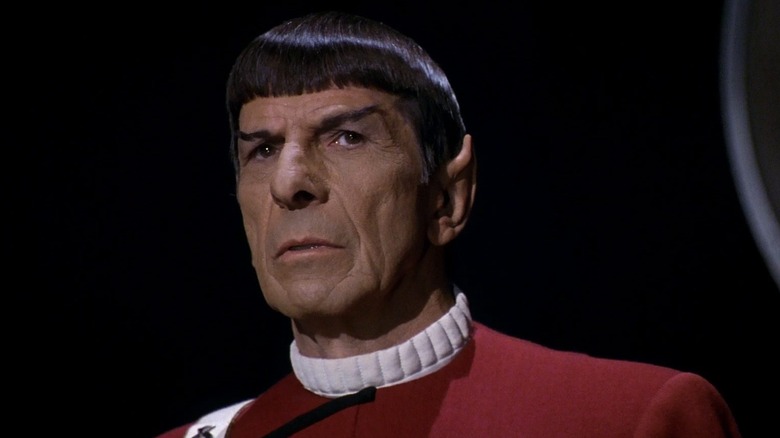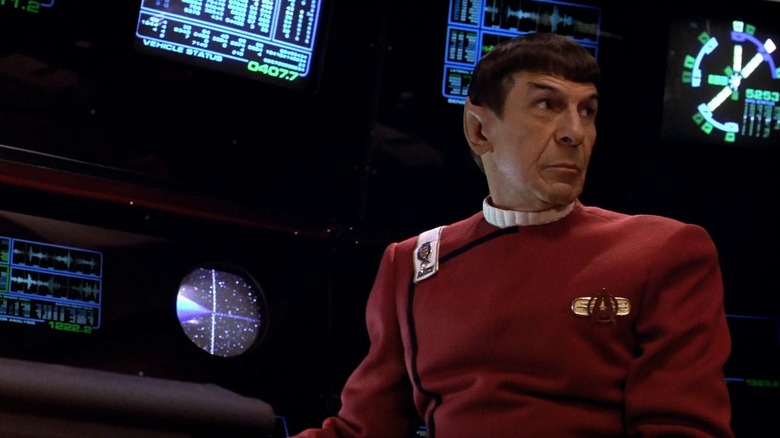Leonard Nimoy's Feud With Gene Roddenberry Killed A Major Star Trek Anniversary Project
We may receive a commission on purchases made from links.
In 1991, the year "Star Trek" turned 25, the franchise was riding high. The hit series "Star Trek: The Next Generation" was finishing up its amazing fourth season, and Nicholas Meyer's feature film "Star Trek VI: The Undiscovered Country" hit theaters that December. Plans were being made for other, bigger "Star Trek" projects, including a new TV series, and the anniversary year was to be marked by the release of endless merchandise. The anniversary was, unfortunately, marked by sadness, as the franchise's creator, Gene Roddenberry, passed away that October at the age of 70.
Roddenberry, an optimist and a (literal plane crash) survivor, will always be beloved for creating "Star Trek," a pop sci-fi series that, as unlikely as it may seem, espoused a progressive philosophy of peace and diplomacy. Roddenberry's vision was utopian, and "Star Trek" had become one of the modern world's most definitive texts on a hopeful future. That's where Gene Roddenberry left us, contemplating our potential.
In person, however, Roddenberry wasn't always diplomatic. Indeed, he frequently wrested control of his "Star Trek" projects from others, bilked people out of their pay, and advocated a little too hard for free love; he loved to see the female "Star Trek" cast members in those 1960s miniskirts. He was also self-aggrandizing, happy to hear people (like me) praise his lofty ideas.
This self-aggrandizement led to a strained relationship with Spock actor Leonard Nimoy. Indeed, in Susan Sackett's 2002 book "Inside Trek: My Secret Life with Star Trek Creator Gene Roddenberry," it was explained that Nimoy put the kibosh on a 25th anniversary "Star Trek" coffee table book for two reasons. One, he didn't like the crass commercialization of the book's language, but also because he refused to feed into the Roddenberry myth.
Leonard Nimoy forced Gene Roddenberry to cancel a 25th anniversary coffee table book
Sackett, it should be noted, was a longtime producer and writer on "Star Trek," and also Gene Roddenberry's personal assistant. Many Trekkies will hasten to add that Sackett was also Roddenberry's girlfriend, a scandalous detail, as their relationship ran parallel to his marriage to Majel Barrett. Sackett was deeply enough involved in "Star Trek" to propose the writing of a 20th anniversary coffee table book in 1986. Sadly, that project never came together because of various legal delays, so it eventually turned into the 25th anniversary book, set to be published in 1991.
It was a massive book, priced at $45.00, and it was to feature extensive interviews with all the "Star Trek" and "Star Trek: The Next Generation" cast members, as well as a slew of new illustrations by artist Richard Arnold.
But the book was never actually published, and Leonard Nimoy was directly responsible. According to Sackett's book, Nimoy was one of the last actors to sign off on photos of Spock that were to be used in the book, and only then began to read the text. Nimoy disapproved of the text, it seems, an objection that came from a closed-door meeting between Nimoy, Nimoy's lawyer, Roddenberry, and Roddenberry's lawyer, Leonard Maizlish. It seems that the book was too commercially coded for Nimoy, and that he would have preferred more highfalutin language that stressed the cultural importance of "Star Trek." As Sackett wrote:
"The book was on hold because Leonard Nimoy didn't think the prose 'lofty enough,' as Maizlish put it, and wanted it more in the style of someone like Bill Moyers."
Moyers was the co-author of the invaluable 1988 tome "The Power of Myth," alongside Joseph Campbell.
Leonard Nimoy had contractual approval over any Star Trek project that used his likeness
Nimoy, the book also pointed out, wasn't getting along with Roddenberry too well in 1991, adding a lot of animosity to the above closed-door meeting. Sackett had once heard a Desilu executive relate that Nimoy hated Roddenberry for his self-aggrandizement habits, and that he didn't like how much credit Roddenberry took for himself. Nimoy refused to sign off on the text of the 25th anniversary book, something that was included in his contract, and he singlehandedly forced the book to be shelved. A lot of the manuscript was eventually repurposed for a 1994 book called "Star Trek: Where No One Has Gone Before – A History in Pictures." Sackett's name does not appear on the cover of that book.
Nimoy's cancelation of the book was well-known to fans thanks to a 1992 article in "Cinefantastique" magazine. That issue explained merely that Nimoy had vetoed the book because he hadn't been consulted, and that Pocket Books placed it on indefinite hold. It also explained that the unpublished book featured a lot of quotes from Roddenberry, all highlighted with bold text, and almost no quotes from the cast or other creative people who worked on the series. Nimoy's contract allowed him to approve of any piece of "Star Trek" ancillary merch that bore his likeness, so he was 100% in his legal right to pull the plug on the project.
In 1996, there was a spate of 30th anniversary writing, and new pieces of writing and merch emerge every five years. In 2026, "Star Trek" will celebrate its 60th anniversary, and it will no doubt inspire further books and magazines. The celebration will never cease.


